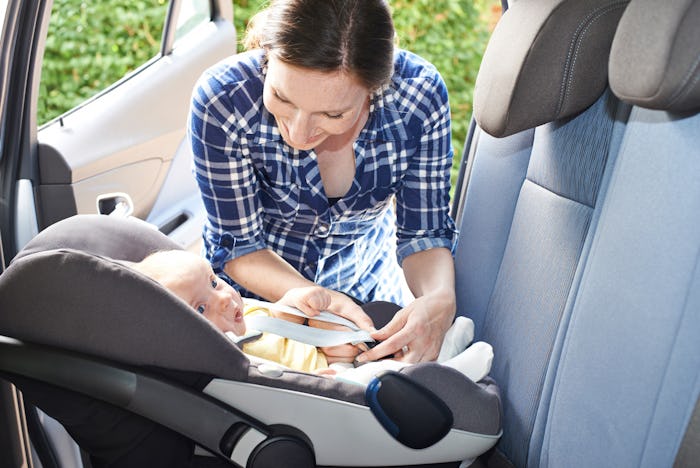Life

7 Myths About Car Seats That Experts Want You To Ignore
Worrying about your child's safety is virtually synonymous with being a parent. You're basically biologically hardwired to protect your offspring from any kind of perceived danger. Despite this age-old evolutionary quirk, you likely have some decidedly modern concerns about your little one's well being. For instance, you might wonder what are the myths about car seats to ignore and which ones are actually rooted in some fact. Since your child is going to spend a lot of time there (depending on how often you hit the road with child the in tow) it's important to get some clarification on the matter.
Somewhere in my mother's house, there's a picture of me as an infant in a car seat that looks like a glorified folding lawn chair. This left me concerned about my own son. How do you know what is legit and what isn't when it comes to car seat safety for your child? With all the opinions floating around out there, it can be difficult to sort through all the noise and get to the bottom of things. Luckily, safety experts have debunked some common car seats myths so that you — and your little one — can travel safely.
Myth #1: You Select A Seat Based On Age
If you've ever asked friends for advice when shopping for a car seat, your child's age is typically brought up as a factor, But, as safety expert Emily Long tells Romper via an email exchange, you have to "take into account your child's size and weight in transition periods, do your research, and avoid comparison with other children of similar age." Instead of going just by how old they are, remember that each child has individual needs.
Myth #2: Comfort Is Key
No parent likes the idea of their baby being uncomfortable during a car ride. But being lax with their buckles isn't worth the small amount of comfort it may provide. "The chest clip should be at armpit level and the harness straps should be snug," Principal Investigator in the Center for Injury Research and Policy at the Research Institute at Nationwide Children's Hospital, Dr. Lara McKenzie tells Romper. How can you make sure the straps are adjusted properly? "Pinch the straps an inch below your child's shoulder between your thumb and index finger," McKenzie says. "If there is excess, you need to tighten."
Myth #3: Bent Legs Means Rear-Facing Is Over
As Baby Trend car seat technician Sabrina Zaremba tells Romper, "people have the misconception that the child has outgrown their rear facing infant seat if their feet touch the vehicle seat." So does this myth have any validity to it? "Children are very flexible and there is less risk of injury when rear facing in the vehicle," Zaremba explains. So don't let a growth spurt deter you from putting your child in the proper position.
Myth #4: The More Expensive The Car Seat, The Better The Quality
Just because you want the best for your child doesn't mean you have to empty the bank account. "There are affordable car seat options on the market that provide all the important safety perks of their more expensive counterparts," Long says. Safety is the top priority and, luckily, you don't need to break any piggy banks for it.
Myth #5: Registering Your Car Seat Is A Waste Of Time
I was once told that the practice of registering your newly-purchased seat was just a marketing ploy. But, in an interview with Romper, safety expert Sage Singleton says it's worth the extra time. "You should register your car seat with the manufacturer," she says. "This way, if there is a safety recall, you will be notified immediately and can replace your car seat with the safer, updated model." Another helpful bit of information is that, "manufactures are required to fix problems for free," Singleton says.
Myth #6: Used Is Just As Good
Sure, everyone loves to save some money. But when it comes to car seats, used is not an option. "You have no way of knowing the true history of a used car seat — whether it's been in an accident or whether it's been properly installed and cared for," Long says. Additionally, she adds that "car seats come with an expiration date because parts and pieces can degrade over time." A safe car seat is worth the investment.
Myth #7: They've Outgrown Car Seats
Just because your child is old enough to protest using a car seat doesn't mean they no longer need one. "Children must use a booster until they reach 4 feet 9 inches and weigh between 80 and 100 pounds," Zaremba says. So what should you look for when your child is tall and weighs enough to use a regular seat belt? Zaremba says you should look for the following signs:
- When the child is seated in the vehicle the child should be seated all the way back against the vehicle seat.
- Their knees should bend comfortably at the edge of the vehicle seat.
- The lap belt should sit low over the thighs with the shoulder across the shoulder between the neck and arm.
These tips will ensure the whole family is safe during travel.